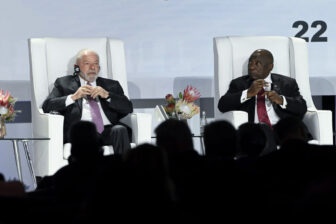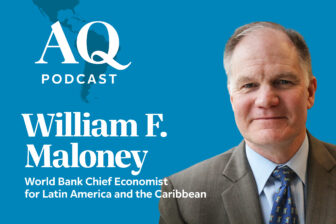SÃO PAULO — The year 2023 began with an armed insurrection in Brazil’s capital when thousands of supporters of former President Jair Bolsonaro stormed Congress, the Supreme Court, and the presidential palace on January 8. The year ended with Argentina’s largest unions calling for national strikes and Venezuela’s President Nicolás Maduro mobilizing troops after a highly controversial referendum about claims on the oil-rich Essequibo region, which belongs to neighboring Guyana.
And yet, despite a challenging macroeconomic and geopolitical scenario, 2023 was not a bad year for Latin America. Throughout the past twelve months, a cautiously optimistic outlook among analysts become increasingly common. Economic growth in 2023 is expected to end up at 2.2%—somewhat better than the 1.7% initially projected, but still below the global average of 3.2%. Most analysts expect growth to decline slightly to 1.9% this year, too little to decisively overcome the deep-seated public discontent that has been so prevalent across Latin America in recent years.
What trends should observers keep an eye on in the region in 2024? Five are worth highlighting:
1. More policy continuity than in previous years
The year ahead can be expected to hold more policy continuity than change across Latin America: Just look at the likely outcomes of a few upcoming presidential races. The Dominican Republic’s Luis Abinader, enjoying approval ratings of around 70%, is the favorite to win reelection in May. A month later, Claudia Sheinbaum, President Andrés Manuel López Obrador’s handpicked successor, will likely be elected in Mexico and is primarily seen as sufficiently pragmatic to assure the country will continue to benefit from U.S. nearshoring.
Despite a profoundly worrisome drift towards authoritarianism, policy continuity is also the most likely scenario in El Salvador, where President Nayib Bukele is set to win reelection comfortably. And none of the region’s most repressive regimes—in Caracas, Havana and Managua—are showing signs of meaningfully changing their policies.
In Brazil, municipal elections in October, seen as a bellwether vote for the presidential contest in 2026, are unlikely to produce a political earthquake. Uruguay’s presidential elections in October are unlikely to keep investors up at night.
2. The growing benefits of being a bystander to geopolitical turmoil
Latin America’s status as a geopolitical bystander has long caught investors’ attention in a world increasingly shaped by tensions on the world stage. Yet, as the wheels seem to be coming off the post-Cold War order, which guaranteed relative geopolitical stability since the early 1990s, Latin America is bound to benefit even more from its distance from the problematic proliferation of interstate wars worldwide. In 2022, the Peace Research Institute Oslo (PRIO) recorded 55 state-based conflicts in 38 countries, the highest figure in decades. The significant potential for escalation of wars in Ukraine and the Middle East, or the emergence of a conflict involving Taiwan, is bound to lead a growing number of investors to consider betting on Latin America to reduce their exposure to geopolitical conflict. This does not mean that Latin America will remain unscathed by continued geopolitical tensions worldwide—but its geographic distance from the main hotspots is increasingly likely to provide it with a comparative advantage over other regions more directly exposed to conflicts.
In this sense, Maduro’s recent overtures vis-à-vis Guyana are worrisome. Yet actual war between Caracas and Georgetown is improbable. It should primarily be understood as the Venezuelan government’s attempt to produce a rally-round-the-flag effect before the upcoming (most likely unfair) elections.
3. Lula seeks the global limelight
In 2023, Brazil’s Lula actively sought the geopolitical limelight, often weighing in controversially on issues such as Russia’s invasion of Ukraine and the war between Israel and Gaza, causing considerable friction between Brazil and the West. This year is likely to see much more of that, partly because of Brazil’s presidency of the G20, which will provide the president with an extra opportunity to seek to set the global agenda. Brazilian Foreign Minister Mauro Vieira’s assertion that Brazil would be “content” to welcome Russia’s president Vladimir Putin to the G20 Summit in November—despite the International Criminal Court’s arrest warrant against Putin—shows that Brazil will not shy away from controversy this year, a reflection of the country’s challenge to craft a foreign policy amidst growing tensions between the West on the one side and Beijing and Moscow on the other. Lula’s trip to Russia for the 2024 BRICS Summit—which Putin will use to show the West that he is not isolated—is bound to generate heated debates about Brazil’s international strategy.
4. All eyes on Argentina
The current political situation in Argentina is typical of a president who was elected on a platform of radical change but lacks the congressional majority to implement it. Though in very different circumstances, Colombia’s Gustavo Petro and Chile’s Gabriel Boric recently encountered something similar. By presenting a slew of presidential decrees and a massive legal package in the first days of his presidency, Javier Milei signals that he will try, nonetheless. Yet the hurdles—in the legislature, the judiciary, and in the streets, where the opposition will organize large protests—are significant, and the president will most likely have to make substantial concessions, just like his peers in Santiago and Bogotá. Still, given the high stakes and Milei’s lack of executive experience, the risk of political turbulence in Argentina in the first half of 2024 is more significant than anywhere else in the region. That will limit Milei’s room for maneuver on the foreign policy front, and his initial moves suggest he will not seek to antagonize the likes of Lula as much as he did during the campaign. That could change in 2025 if Donald Trump returns to the White House, allowing Milei to swim in the U.S. slipstream and radicalize on the foreign policy front, just like Bolsonaro did during his first two years as president when Trump was in power.
5. Changing weather patterns impact Latin America’s economy
If 2023 was any guide, El Niño, which disrupts weather patterns across the region due to increased water temperatures in the Pacific, may continue to impact Latin American economies in a variety of ways, causing droughts in some places (such as Central America, Colombia and the Amazon) and increased rainfall in others (Northern Mexico, Paraguay, Uruguay and parts of Argentina), adding uncertainty to countries that are dependent on agricultural production. The biggest loser in the region may be Panama, where the Panama Canal may see itself forced to cut the number of ships passing through, as it did in 2023.
Taken together, these trends point to a somewhat more stable scenario in Latin America—particularly when compared to the rest of the world, where all eyes will be on the war in the Middle East, Russia’s invasion of Ukraine, the U.S. presidential elections and growing geopolitical tensions in Asia.









